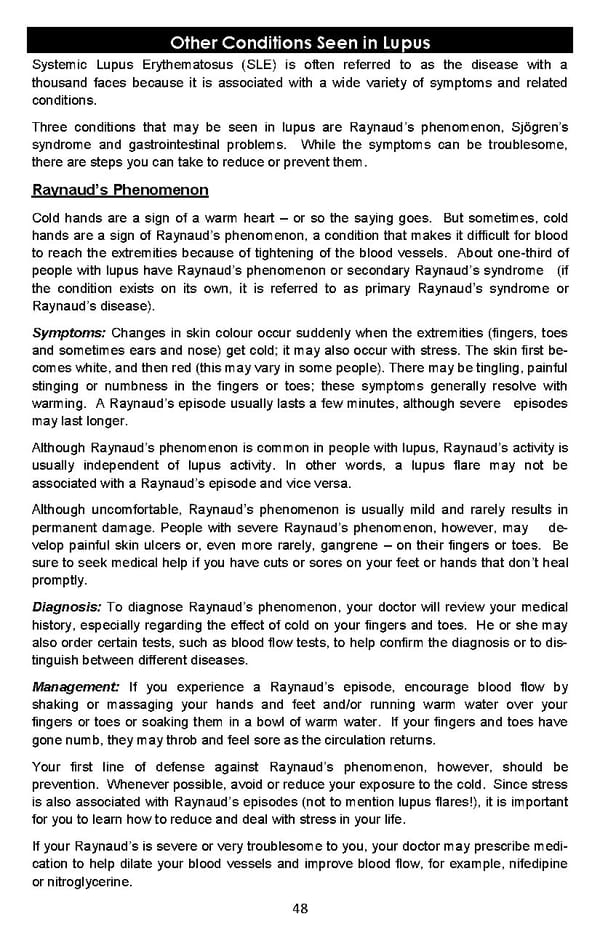Other Conditions Seen in Lupus Systemic Lupus Erythematosus (SLE) is often referred to as the disease with a thousand faces because it is associated with a wide variety of symptoms and related conditions. Three conditions that may be seen in lupus are Raynaud’s phenomenon, Sjögren’s syndrome and gastrointestinal problems. While the symptoms can be troublesome, there are steps you can take to reduce or prevent them. Raynaud’s Phenomenon Cold hands are a sign of a warm heart – or so the saying goes. But sometimes, cold hands are a sign of Raynaud’s phenomenon, a condition that makes it difficult for blood to reach the extremities because of tightening of the blood vessels. About one-third of people with lupus have Raynaud’s phenomenon or secondary Raynaud’s syndrome (if the condition exists on its own, it is referred to as primary Raynaud’s syndrome or Raynaud’s disease). Symptoms: Changes in skin colour occur suddenly when the extremities (fingers, toes and sometimes ears and nose) get cold; it may also occur with stress. The skin first be- comes white, and then red (this may vary in some people). There may be tingling, painful stinging or numbness in the fingers or toes; these symptoms generally resolve with warming. A Raynaud’s episode usually lasts a few minutes, although severe episodes may last longer. Although Raynaud’s phenomenon is common in people with lupus, Raynaud’s activity is usually independent of lupus activity. In other words, a lupus flare may not be associated with a Raynaud’s episode and vice versa. Although uncomfortable, Raynaud’s phenomenon is usually mild and rarely results in permanent damage. People with severe Raynaud’s phenomenon, however, may de- velop painful skin ulcers or, even more rarely, gangrene – on their fingers or toes. Be sure to seek medical help if you have cuts or sores on your feet or hands that don’t heal promptly. Diagnosis: To diagnose Raynaud’s phenomenon, your doctor will review your medical history, especially regarding the effect of cold on your fingers and toes. He or she may also order certain tests, such as blood flow tests, to help confirm the diagnosis or to dis- tinguish between different diseases. Management: If you experience a Raynaud’s episode, encourage blood flow by shaking or massaging your hands and feet and/or running warm water over your fingers or toes or soaking them in a bowl of warm water. If your fingers and toes have gone numb, they may throb and feel sore as the circulation returns. Your first line of defense against Raynaud’s phenomenon, however, should be prevention. Whenever possible, avoid or reduce your exposure to the cold. Since stress is also associated with Raynaud’s episodes (not to mention lupus flares!), it is important for you to learn how to reduce and deal with stress in your life. If your Raynaud’s is severe or very troublesome to you, your doctor may prescribe medi- cation to help dilate your blood vessels and improve blood flow, for example, nifedipine or nitroglycerine. 48
 Living Well With Lupus Facts Booklet Page 47 Page 49
Living Well With Lupus Facts Booklet Page 47 Page 49